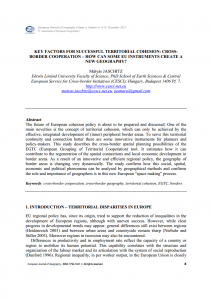Hungarian overview
literature

Information
Author
Mátyás Jaschitz
Year of publication
2013
Language
English (EN)
Download
Share
KEY FACTORS FOR SUCCESSFUL TERRITORIAL COHESION: CROSSBORDER COOPERATION – HOW CAN SOME EU INSTRUMENTS CREATE A NEW GEOGRAPHY?
Abstract
The future of European cohesion policy is about to be prepared and discussed: One of the main novelties is the concept of territorial cohesion, which can only be achieved by the effective, integrated development of (inner) peripheral border areas. To serve this territorial continuity and connection better there are some innovative instruments for planners and policy-makers.
This study describes the cross-border spatial planning possibilities of the EGTC (European Grouping of Territorial Cooperation) tool. It estimates how it can contribute to the regeneration of the spatial connections and local economic development in border areas. As a result of an innovative and efficient regional policy, the geography of border areas is changing very dynamically. The study confirms how this social, spatial, economic and political phenomena can be analysed by geographical methods and confirms the role and importance of geographers is in this new European “space making” process.